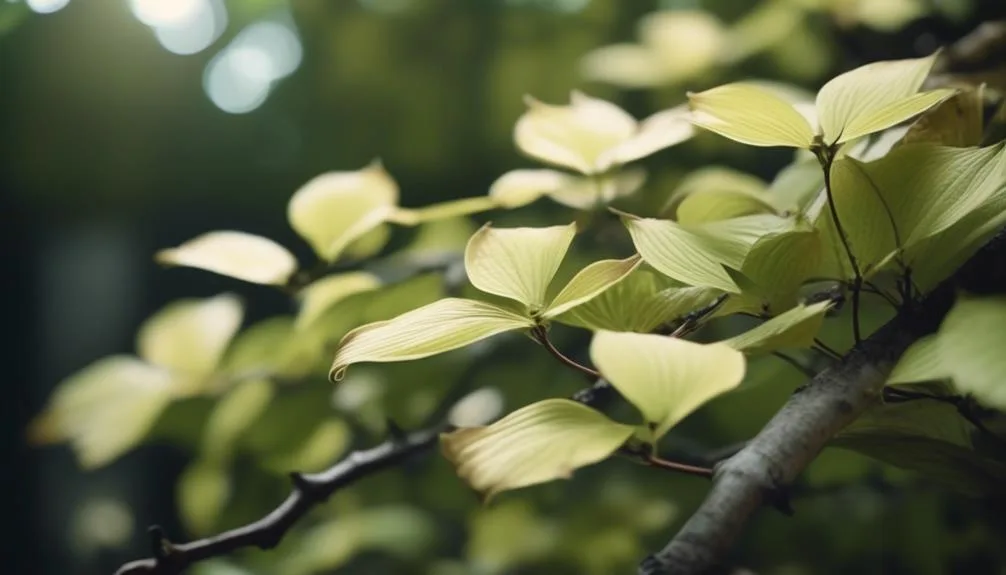Ever wondered how to tell different dogwood tree species apart just by looking at them?
The way their leaves, flowers, bark, and where they grow differ could be the key. Understanding these features helps you appreciate the variety of dogwood trees and connect with nature.
But how can you spot these differences? Let's explore the world of dogwood tree species and find the clues that make each one unique.
Physical Characteristics
When you observe dogwood trees, you'll notice that their physical characteristics vary depending on the species, including differences in leaf shape, bark texture, and overall size.
The size of dogwood trees can range from small shrubs to medium-sized trees, with some species growing up to 20 feet tall.
As for blossom color, different species exhibit a variety of hues, including white, pink, and red. When in bloom, these colors create a stunning visual display in gardens and woodland areas.
The leaves also vary in shape, with some species having broad, ovate leaves, while others have more elongated or pointed leaf shapes.
The bark texture can range from smooth to rough, and even patterned, adding to the unique visual appeal of each species.
Leaf and Flower Features
You'll marvel at the diverse leaf shapes and vibrant blossom colors that distinguish different dogwood tree species.
Dogwood leaves come in shades of green, often with hints of red or purple in the fall. They can be oval, lance-shaped, or even resemble an exaggerated heart.
Meanwhile, dogwood flowers exhibit a wide range of colors, including white, pink, and red. Their petals can be rounded, pointed, or even slightly indented, adding to the allure of these beautiful trees. Flower size varies, with some species producing small clusters, while others boast large, showy blooms.
Observing the leaf color, petal shape, leaf size, and flower color is crucial in identifying and appreciating the unique characteristics of different dogwood tree species.
Bark and Branch Structure
As you examine the dogwood tree closely, the intricate patterns and textures of its bark and the graceful arching of its branches reveal distinctive characteristics that contribute to the beauty and identity of each species.
In winter, bark becomes a crucial feature for identification. The bark of the flowering dogwood, for instance, displays a distinct blocky pattern, while the rough-ridged bark of the kousa dogwood sets it apart.
Additionally, examining the branch structure can aid in tree aging. Older dogwood trees often have more gnarled and twisted branches, while younger trees typically display smoother and more flexible branches.
Geographic Distribution
The geographic distribution of dogwood tree species varies widely, with different species thriving in diverse environments across North America. Here's a breakdown of the climate preferences and soil requirements for some common dogwood tree species:
| Species | Climate Preferences | Soil Requirements |
|---|---|---|
| Flowering Dogwood | Moderate to cool climates | Well-drained, acidic |
| Pacific Dogwood | Cool, moist climates | Rich, well-drained |
| Roughleaf Dogwood | Warm, humid climates | Moist, fertile |
| Redosier Dogwood | Wide range of climates | Adaptable, moist |
Understanding the geographic distribution and specific environmental needs of each dogwood species is crucial for successful cultivation and conservation efforts. By matching the right species to the right conditions, you can ensure the health and vitality of these beautiful trees in your local area.
Comparison With Similar Species
To understand how different dogwood tree species compare with similar species, it's essential to consider their unique climate preferences and soil requirements, which we've just explored in detail.
When comparing dogwood species with similar trees, it's important to note their growth patterns. For instance, the flowering dogwood typically grows as an understory tree, while the Kousa dogwood is known for its strong horizontal branching. This can help distinguish between the two species when observing them in their natural habitats.
Additionally, examining the differences in fruit and seed characteristics can aid in identification. For example, the fruit of the Pacific dogwood is a cluster of small red berries, whereas the roughleaf dogwood produces bluish-black berries.
These distinctions in growth patterns and fruit and seed differences provide valuable clues for distinguishing between different dogwood tree species and their similar counterparts.
Conclusion
Intriguing and beautiful, the world of dogwood trees offers a diverse range of species waiting to be discovered. By observing their unique physical features and geographic distribution, you can appreciate the rich variety they bring to the natural landscape.
What wonders will you uncover on your next encounter with a dogwood tree?

My interest in trees started when I first saw the giant sequoias in Yosemite.
I was a teenager then, and I remember thinking, “I need to learn more about this.”
That moment stuck with me.
A few years later, I went on to study forestry at Michigan Tech.
Since graduating, I’ve worked in a mix of hands-on tree care and community education.
I’ve spent over ten years helping people understand how to plant, maintain, and protect the trees in their neighborhoods.
I don’t see trees as just part of the landscape.
They are living things that make a real difference in our daily lives.
